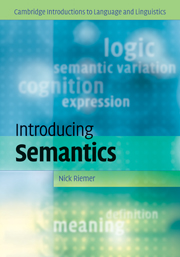Book contents
- Frontmatter
- Contents
- Note to the reader
- 1 Meaning in the empirical study of language
- 2 Meaning and definition
- 3 The scope of meaning I: external context
- 4 The scope of meaning II: interpersonal context
- 5 Analysing and distinguishing meanings
- 6 Logic as a representation of meaning
- 7 Meaning and cognition I: categorization and cognitive semantics
- 8 Meaning and cognition II: formalizing and simulating conceptual representations
- 9 Meaning and morphosyntax I: the semantics of grammatical categories
- 10 Meaning and morphosyntax II: verb meaning and argument structure
- 11 Semantic variation and change
- Glossary
- References
- Index
9 - Meaning and morphosyntax I: the semantics of grammatical categories
Published online by Cambridge University Press: 05 June 2012
- Frontmatter
- Contents
- Note to the reader
- 1 Meaning in the empirical study of language
- 2 Meaning and definition
- 3 The scope of meaning I: external context
- 4 The scope of meaning II: interpersonal context
- 5 Analysing and distinguishing meanings
- 6 Logic as a representation of meaning
- 7 Meaning and cognition I: categorization and cognitive semantics
- 8 Meaning and cognition II: formalizing and simulating conceptual representations
- 9 Meaning and morphosyntax I: the semantics of grammatical categories
- 10 Meaning and morphosyntax II: verb meaning and argument structure
- 11 Semantic variation and change
- Glossary
- References
- Index
Summary
CHAPTER PREVIEW
This chapter and the next investigate a range of semantic phenomena which are relevant to morphosyntax. This chapter focuses on morphosyntactic categories such as noun and verb and tense and aspect. The major questions are these:
Does a word's meaning determine its grammatical category?
How can we describe the meanings of major verbal categories like tense and aspect?
We begin with a discussion of the meaning of lexical categories (parts of speech), exploring the possible semantic contribution made by a word's categorization as noun, verb, adjective, and so on (9.1). Section 9.2 focuses on the verb, investigating the semantics of tense and aspect: two central dimensions of verb meaning with major consequences on the verbal and clausal levels.
The semantics of parts of speech
Analysing a language grammatically involves analysing it into a variety of elements and structures: phonemes, morphemes and words, and, within the words, syntactic categories of various sorts. Among these categories are the parts of speech (also known as lexical or grammatical categories): noun, verb, adjective, determiner and so on. We usually think of these classifications as inherent properties of words. We imagine, in other words, that the lexicon of English is arranged with each word specified as belonging to a particular part of speech, or sometimes to several parts of speech. A word's membership in a particular part of speech category is thus one of its inherent properties. As a result, we say that quickly is an adverb; woman a noun and capsize a verb; on the other hand, catch is both noun and verb (a catch; to catch), and green is noun, verb and adjective (They are on the green; the council is greening the city; I like green asparagus).
- Type
- Chapter
- Information
- Introducing Semantics , pp. 287 - 334Publisher: Cambridge University PressPrint publication year: 2010

